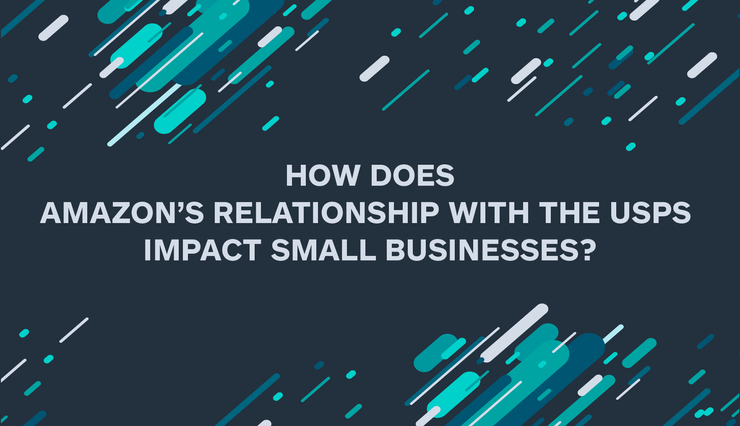How Does Amazon’s Relationship with the USPS Impact Small Businesses?


Amazon is a shipping powerhouse: more than 5 billion items were sent to Prime customers last year, with delivery costs reaching $21.7 billion. To support its shipping needs, Amazon has developed parts of its own delivery infrastructure, but it also relies on regional and national carriers, including the USPS.
Recent events, however, beg the question: is Amazon’s relationship with the USPS mutually beneficial or one more akin to a leech? In other words, is Amazon sucking the life’s blood out of the USPS (and perhaps, the American people in general!)?
As speculation about Amazon, retailers, and the USPS take center stage, it’s important to understand what’s fact and what’s fiction. We fact-checked some of the popular myths. Here’s the breakdown.
Is the USPS giving Amazon a sweetheart deal? Yes.
Of course, it is! All of the major carriers negotiate rates with high-volume shippers like Amazon. As one of the Postal Service’s largest parcel shippers, Amazon has access to rates that are much lower than retail prices, perhaps lower rates than the USPS offers anyone else.
What makes the USPS unique is that it cannot price parcel delivery below cost, due to the 2006 Postal Accountability and Enhancement Act. It states, “By law, our competitive package products, including those that we deliver for Amazon, must cover their costs. The Postal Regulatory Commission (PRC) looks carefully at this question every year and has determined that they do.”
Does Amazon pay a “fair” rate for packages shipped via the USPS? Yes and No.
Package delivery is the fastest-growing segment of the USPS. In its 2018 fiscal first quarter earnings, the Shipping and Packages group saw revenue climb 9.3 percent to $505 million. And, package volumes grew by 111 million pieces or approximately 7 percent.
If the USPS wanted to make more money, why don’t they raise rates? This would seem like a logical response, but the reality isn’t so black and white.
UPS, FedEx, and DHL (which recently jumped back into the fray), along with hundreds of regional carriers, all compete with the USPS on parcel deliveries, often at very aggressive rates. If the USPS raised its rates, Amazon could move to a different carrier.
We also need to consider Amazon’s trove of resources. Amazon uses the USPS and other carriers for the “last mile”, which means Amazon transports the package the long distance to a local Post Office distribution center. Recently, Amazon has beefed up its efforts in handling even the “last mile”, essentially competing with the USPS. The more the USPS charges for its services, the more incentive Amazon has to speed up those efforts.
Does the relationship between Amazon and the USPS exploit U.S. taxpayer dollars? No.
The USPS is a unique government entity since it’s operating expenses are not paid for by taxpayer dollars. It’s independent of the government budget; and therefore, the American taxpayer is not subsidizing the cost of package delivery via the U.S. Postal Service.
Is Amazon destroying retailers and small businesses? Yes and No.
Amazon has changed the way people shop, and the retail industry continues to feel the effects. Toys ‘R’ Us, for example, joined a long list of companies that have closed or filed for bankruptcy. While physical retailers are struggling, Amazon is sitting pretty. Amazon is now worth more than the 15 most well-known retailers combined.
Consumers today, yearn for authentic and unique experiences, which opens up great opportunities for brands to differentiate themselves from Amazon. While Amazon is searchable and convenient for finding items when you know exactly what you’re looking for, smaller brands have an opportunity to curate a unique shopping experience for people who are looking to discover something new or different.
There’s a new wave of direct-to-consumer brands, for example, seeing massive success. These are small companies with low overhead, that have high design merchandise, and are supremely efficient with customer acquisition tactics. Many of these brands are generating over $10 million in sales each by using e-commerce platforms and social networks to keep overhead to a minimum. Without writing a single piece of code, they integrate shopping carts, payment systems, and shipping software to create a successful store that lets them concentrate on their core differentiator: connecting with their customers. Easy access to reliable e-commerce infrastructure frees them to focus on strong brand identities and selling carefully curated products.
Sure, Amazon benefits from its relationship with the USPS. But by pursuing the right approach that resonates with their audience, retailers of all sizes can pull different levers for growth and success. While Amazon has raised the bar on “fast and free” shipping, there is no shortage of customer expectations that small e-commerce retailers are especially qualified to meet.
This article originally appeared on Inc. You might also be interested in my Inc. article on President Trump’s executive order to review the finances of the USPS.
Shippo is a multi-carrier API and web app that helps retailers, marketplaces and platforms connect to a global network of carriers. Businesses use Shippo to get real-time rates, print labels, automate international paperwork, track packages and facilitate returns. Shippo provides the tools to help businesses succeed through shipping.












